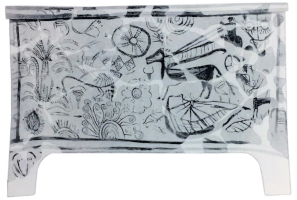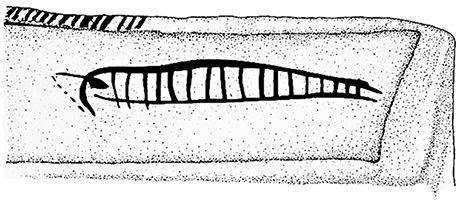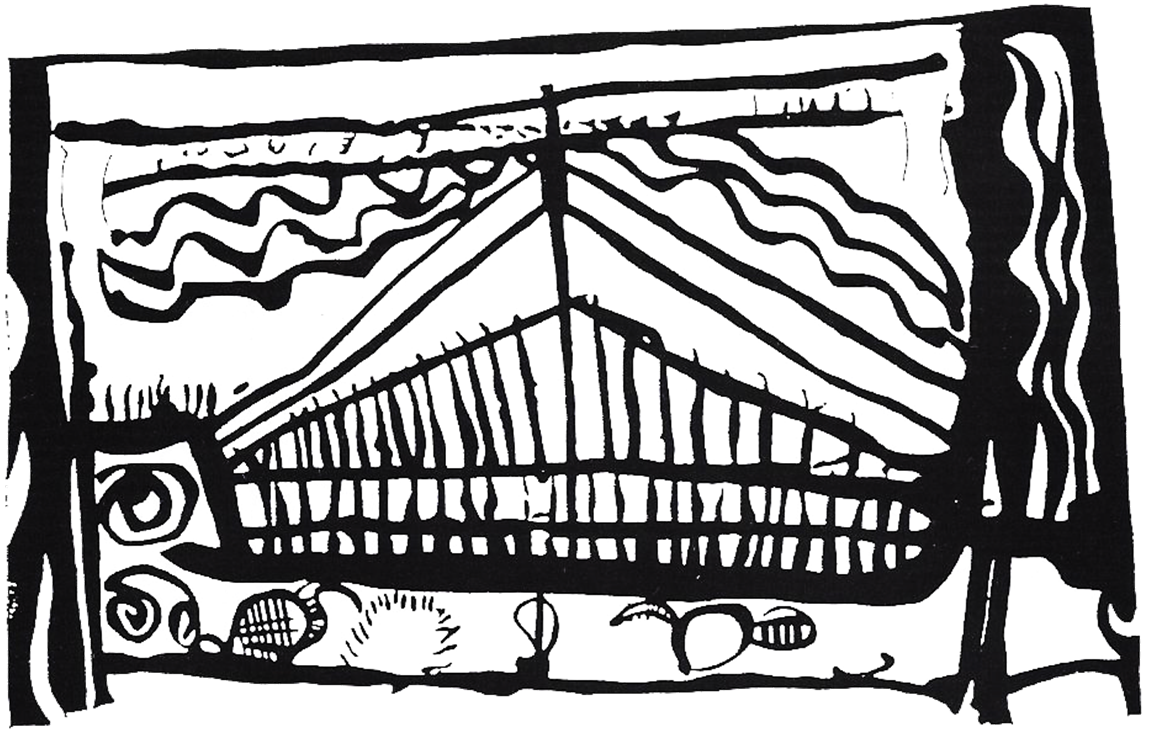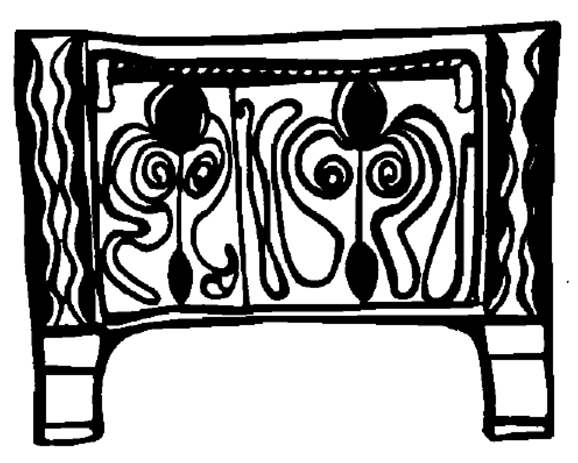Ship to the left with a flat hull, slightly rising spur, and near-vertical stempost that terminates in a zoomorphic hybrid monster device adorned with nine short vertical strokes along the upper edge. The stem rises nearly vertically, above the height of the bow. The steering oar extends horizontally and has a rectangular blade that extends outside of the decorative border. There are two horizontal lines running parallel to the hull, to which they are connected by 26 vertical parallel lines as well as the mast amidships. The mast extends beyond the upper framing line, with two fore- and backstays leading diagonally from the mast to the stem and sternposts. The two horizontal lines at the top of the mast in the upper edge of the frame are interpreted as the yard and boom with the sail furled between them. At midmast, two diagonal lines extend downwards to the stem and stern. These are connected with the upper horizontal line by 25 vertical parallel lines, for the most part independent of the lines joining the two horizontal lines to the keel line. Below the hull there are two birds with down curving beaks placed antithetically and vegetation motifs (palm tree and a flower ?), with spirals filling the space in front of the ship. Two vertical wavy lines above the quarter rudder, and two additional sets of three wavy lines placed beneath the yard on either side of the sail.
Helladic galley
A84
LM IIIB (c. 1200)
Gazi (Skaphidara), near Knossos
L: 85 cm; W: 39 cm; H (with legs): 68
Painted clay larnax
Herakleion Archaeological Museum 18985
Alexiou 1972; 1973; Aubert 1995; Basch 1987: 144-45, no. 303; Delivorrias 1987: 29, nr V; Wachsmann 1981: 203, fig. 16; 1998: 137-39, fig. 7.19; Wedde 2000: 320, no. 608
Rock cut tomb dated by pottery to LM IIIB. Back panel decoration of the larnax consists of two giant octopuses. The side panels consist of two superimposed registers each showcasing an oxhide ingot.1 Aubert thinks that this horizontal separation could be a means to simulate shelves on which the ingots were stacked, drawing a parallel with Egyptian frescoes (Aubert 1995: 34).
1. Alternatively the motif has been interpreted as a biconcave altar (Alexiou 1973; Waltrous 1991: 293).
This is the largest depiction of LBA Aegean craft, although the depiction poses certain problems. The cutwater bow or spur resembles the one on the Tragana ship. The main problem is interpreting the two horizontal bands above the hull seemingly divided by stanchions. The upper one possibly represents decorations hanging from the rigging similar to those observed on the Theran ships. Wachsmann discusses several possibilities but finds them all problematic (Wachsmann 1998: 138). Basch on the other hand reads the lower one as a wale. The artist appears to have used horizontal lines rather liberally. The ship is presumably a penteconter.
Alexiou, S. 1972. “Λάρνακες καὶ ἀγγεῖα ἐκ τάφου παρὰ τὸ Γάζι Ηρακλείου,” ΑΕphem: 86-98.
―――. 1973. “Νέα παράστασις πλοίου ἐπὶ μινωϊκῆς λάρνακος,” in Πεπραγμένα του Γ΄ Διεθνούς Κρητολογικού Συνεδρίου, Ρέθυμνον 18-23 Σεπτεμβρίου 1971 (τόμος A). Αθήνα, pp. 3-12.
Aubert, C. 1995. “Nouvelle interprétation du décor de la Larnax de Gazi no 18985, ” in H. Tzalas (ed.) Tropis III: Proceedings of the 3rd International Symposium on Ship Construction in Antiquity, Athens 24, 25, 26, 27 August 1989. Athens: Hellenic Institute for the Preservation of Nautical Tradition, pp. 31-42.
Basch, L. 1987. Le musée imaginaire de la marine antique. Athens: Institut Hellénique pour la preservation de la tradition nautique.
Delivorrias, A. (ed.) 1987. Greece and the Sea. Catalogue of the exhibition organized by: the Greek Ministry of Culture, the Benaki Museum, the National Foundation De Nieuwe Kerk, Amsterdam, in honour of Amsterdam Cultural Capital of Europe 1987. Athens.
Wachsmann, S. 1981. “The Ships of the Sea People,” IJNA 10: 187-220.
―――. 1998. Seagoing Ships & Seamanship in the Bronze Age Levant. College Station, TX: Texas A&M University Press.
Wedde, M. 2000. Towards a Hermeneutics of Aegean Bronze Age Ship Imagery. Peleus Studien zur Archäologie und Geschichte Griechenlands und Zyperns, vol. 6. Bibliopolis: Mannheim and Möhnsee.










